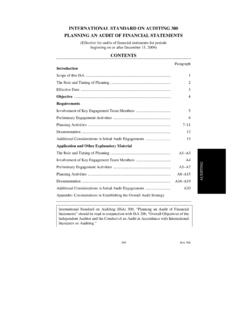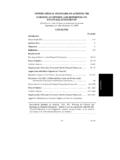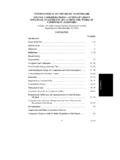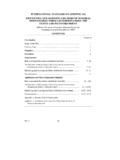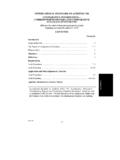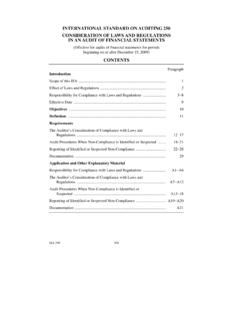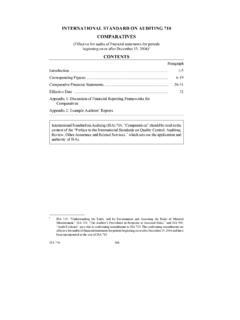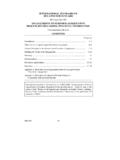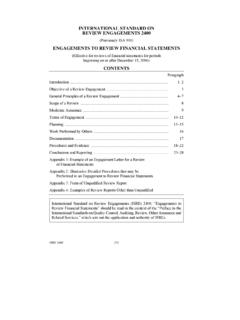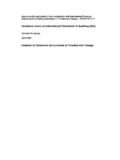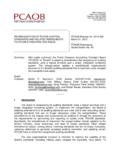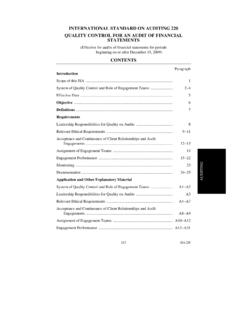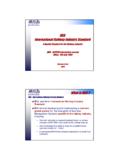Transcription of INTERNATIONAL STANDARD ON AUDITING 530 AUDIT ... - …
1 ISA 530 441 AUDITING INTERNATIONAL STANDARD ON AUDITING 530 AUDIT SAMPLING (Effective for audits of financial statements for periods beginning on or after December 15, 2009) CONTENTS Paragraph Introduction Scope of this ISA .. 1 2 Effective Date .. 3 Objective .. 4 Definitions .. 5 Requirements Sample Design, Size and Selection of Items for Testing .. 6 8 Performing AUDIT Procedures .. 9 11 Nature and Cause of Deviations and Misstatements .. 12 13 Projecting Misstatements .. 14 Evaluating Results of AUDIT Sampling .. 15 Application and Other Explanatory Material Definitions .. A1 A3 Sample Design, Size and Selection of Items for Testing .. A4 A13 Performing AUDIT Procedures .. A14 A16 Nature and Cause of Deviations and Misstatements .. A17 Projecting Misstatements .. A18 A20 Evaluating Results of AUDIT Sampling .. A21 A23 Appendix 1: Stratification and Value-Weighted Selection Appendix 2: Examples of Factors Influencing Sample Size for Tests of Controls Appendix 3: Examples of Factors Influencing Sample Size for Tests of Details Appendix 4: Sample Selection Methods AUDIT SAMPLING ISA 530 442 INTERNATIONAL STANDARD on AUDITING (ISA) 530, AUDIT Sampling should be read in conjunction with ISA 200, Overall Objectives of the Independent Auditor and the Conduct of an AUDIT in Accordance with INTERNATIONAL standards on AUDITING .
2 AUDIT SAMPLING ISA 530 443 AUDITING Introduction Scope of this ISA 1. This INTERNATIONAL STANDARD on AUDITING (ISA) applies when the auditor has decided to use AUDIT sampling in performing AUDIT procedures. It deals with the auditor s use of statistical and non-statistical sampling when designing and selecting the AUDIT sample, performing tests of controls and tests of details, and evaluating the results from the sample. 2. This ISA complements ISA 500,1 which deals with the auditor s responsibility to design and perform AUDIT procedures to obtain sufficient appropriate AUDIT evidence to be able to draw reasonable conclusions on which to base the auditor s opinion. ISA 500 provides guidance on the means available to the auditor for selecting items for testing, of which AUDIT sampling is one means.
3 Effective Date 3. This ISA is effective for audits of financial statements for periods beginning on or after December 15, 2009. Objective 4. The objective of the auditor, when using AUDIT sampling, is to provide a reasonable basis for the auditor to draw conclusions about the population from which the sample is selected. Definitions 5. For purposes of the ISAs, the following terms have the meanings attributed below: (a) AUDIT sampling (sampling) The application of AUDIT procedures to less than 100% of items within a population of AUDIT relevance such that all sampling units have a chance of selection in order to provide the auditor with a reasonable basis on which to draw conclusions about the entire population. (b) Population The entire set of data from which a sample is selected and about which the auditor wishes to draw conclusions.
4 (c) Sampling risk The risk that the auditor s conclusion based on a sample may be different from the conclusion if the entire population were subjected to the same AUDIT procedure. Sampling risk can lead to two types of erroneous conclusions: (i) In the case of a test of controls, that controls are more effective than they actually are, or in the case of a test of 1 ISA 500, AUDIT Evidence. AUDIT SAMPLING ISA 530 444details, that a material misstatement does not exist when in fact it does. The auditor is primarily concerned with this type of erroneous conclusion because it affects AUDIT effectiveness and is more likely to lead to an inappropriate AUDIT opinion. (ii) In the case of a test of controls, that controls are less effective than they actually are, or in the case of a test of details, that a material misstatement exists when in fact it does not.
5 This type of erroneous conclusion affects AUDIT efficiency as it would usually lead to additional work to establish that initial conclusions were incorrect. (d) Non-sampling risk The risk that the auditor reaches an erroneous conclusion for any reason not related to sampling risk. (Ref: Para. A1) (e) Anomaly A misstatement or deviation that is demonstrably not representative of misstatements or deviations in a population. (f) Sampling unit The individual items constituting a population. (Ref: Para. A2) (g) Statistical sampling An approach to sampling that has the following characteristics: (i) Random selection of the sample items; and (ii) The use of probability theory to evaluate sample results, including measurement of sampling risk. A sampling approach that does not have characteristics (i) and (ii) is considered non-statistical sampling.
6 (h) Stratification The process of dividing a population into sub-populations, each of which is a group of sampling units which have similar characteristics (often monetary value). (i) Tolerable misstatement A monetary amount set by the auditor in respect of which the auditor seeks to obtain an appropriate level of assurance that the monetary amount set by the auditor is not exceeded by the actual misstatement in the population. (Ref: Para. A3) (j) Tolerable rate of deviation A rate of deviation from prescribed internal control procedures set by the auditor in respect of which the auditor seeks to obtain an appropriate level of assurance that the rate of deviation set by the auditor is not exceeded by the actual rate of deviation in the population. AUDIT SAMPLING ISA 530 445 AUDITING Requirements Sample Design, Size, and Selection of Items for Testing 6.
7 When designing an AUDIT sample, the auditor shall consider the purpose of the AUDIT procedure and the characteristics of the population from which the sample will be drawn. (Ref: Para. A4 A9) 7. The auditor shall determine a sample size sufficient to reduce sampling risk to an acceptably low level. (Ref: Para. A10 A11) 8. The auditor shall select items for the sample in such a way that each sampling unit in the population has a chance of selection. (Ref: Para. A12 A13) Performing AUDIT Procedures 9. The auditor shall perform AUDIT procedures, appropriate to the purpose, on each item selected. 10. If the AUDIT procedure is not applicable to the selected item, the auditor shall perform the procedure on a replacement item. (Ref: Para. A14) 11. If the auditor is unable to apply the designed AUDIT procedures, or suitable alternative procedures, to a selected item, the auditor shall treat that item as a deviation from the prescribed control, in the case of tests of controls, or a misstatement, in the case of tests of details.
8 (Ref: Para. A15 A16) Nature and Cause of Deviations and Misstatements 12. The auditor shall investigate the nature and cause of any deviations or misstatements identified, and evaluate their possible effect on the purpose of the AUDIT procedure and on other areas of the AUDIT . (Ref: Para. A17) 13. In the extremely rare circumstances when the auditor considers a misstatement or deviation discovered in a sample to be an anomaly, the auditor shall obtain a high degree of certainty that such misstatement or deviation is not representative of the population. The auditor shall obtain this degree of certainty by performing additional AUDIT procedures to obtain sufficient appropriate AUDIT evidence that the misstatement or deviation does not affect the remainder of the population. Projecting Misstatements 14.
9 For tests of details, the auditor shall project misstatements found in the sample to the population. (Ref: Para. A18 A20) Evaluating Results of AUDIT Sampling 15. The auditor shall evaluate: (a) The results of the sample; and (Ref: Para. A21 A22) AUDIT SAMPLING ISA 530 446(b) Whether the use of AUDIT sampling has provided a reasonable basis for conclusions about the population that has been tested. (Ref: Para. A23) ** Application and Other Explanatory Material Definitions Non-Sampling Risk (Ref: Para. 5(d)) A1. Examples of non-sampling risk include use of inappropriate AUDIT procedures, or misinterpretation of AUDIT evidence and failure to recognize a misstatement or deviation. Sampling Unit (Ref: Para. 5(f)) A2. The sampling units might be physical items (for example, checks listed on deposit slips, credit entries on bank statements, sales invoices or debtors balances) or monetary units.
10 Tolerable Misstatement (Ref: Para. 5(i)) A3. When designing a sample, the auditor determines tolerable misstatement in order to address the risk that the aggregate of individually immaterial misstatements may cause the financial statements to be materially misstated and provide a margin for possible undetected misstatements. Tolerable misstatement is the application of performance materiality, as defined in ISA 320,2 to a particular sampling procedure. Tolerable misstatement may be the same amount or an amount lower than performance materiality. Sample Design, Size, and Selection of Items for Testing Sample Design (Ref: Para. 6) A4. AUDIT sampling enables the auditor to obtain and evaluate AUDIT evidence about some characteristic of the items selected in order to form or assist in forming a conclusion concerning the population from which the sample is drawn.
